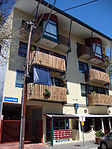Chinatown, Adelaide
Adelaide stubsAsian-Australian culture in South AustraliaChinatowns in AustraliaCulture of AdelaideRestaurant districts and streets in Australia ... and 2 more
Tourist attractions in AdelaideUse Australian English from January 2014

Chinatown in Adelaide, South Australia, Australia, also called Adelaide Chinatown or Moonta Street Chinatown, is located on Moonta Street, within the large Adelaide Central Markets precinct between Grote and Gouger streets in the Adelaide city centre. Two large Paifang, which were erected by the city council, are guarded by the Chinese guardian lions. They mark the entrances at either end. Adelaide Chinatown consists mainly of Chinese restaurants, grocery stores and markets but also consists of many non-Chinese Asian restaurants offering cuisines of Indian, Japanese, Korean, Malaysian, Nepali, Thai and Vietnamese origins.
Excerpt from the Wikipedia article Chinatown, Adelaide (License: CC BY-SA 3.0, Authors, Images).Chinatown, Adelaide
Moonta Street, Adelaide Adelaide
Geographical coordinates (GPS) Address Nearby Places Show on map
Geographical coordinates (GPS)
| Latitude | Longitude |
|---|---|
| N -34.93 ° | E 138.596 ° |
Address
Commonwealth Bank
Moonta Street
5000 Adelaide, Adelaide
South Australia, Australia
Open on Google Maps







